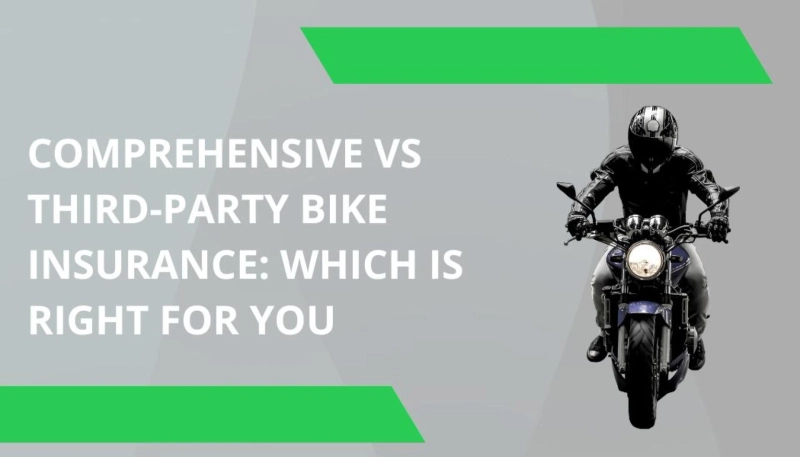For millions of bike owners in India, having insurance is not just a legal requirement but also a vital financial safeguard. Yet, one of the most common dilemmas riders face is deciding between third-party bike insurance and comprehensive bike insurance.
Both options serve important purposes, but they differ significantly in terms of coverage, cost, and long-term value. Choosing the right one depends on your needs, your riding habits, and the value of your vehicle.
This article will help you understand the differences between the two and guide you toward making the right decision.
What is Third-Party Bike Insurance?
Third-party insurance is the most basic and mandatory form of coverage required under the Motor Vehicles Act in India. As the name suggests, it covers damages caused to a third party—whether it’s another person, vehicle, or property—due to an accident involving your bike.
The premium for third-party insurance is relatively low, making it attractive for budget-conscious riders. However, the downside is that it does not cover any damage to your own bike or personal injuries. Essentially, this policy protects others from financial loss but leaves you to bear the cost of repairing or replacing your own vehicle.
What is Comprehensive Bike Insurance?
Comprehensive bike insurance, on the other hand, offers complete protection. In addition to third-party liability coverage, it also covers damages to your own bike caused by accidents, natural disasters, theft, vandalism, or fire. Some policies also provide personal accident cover for the rider and pillion.
The premium for comprehensive coverage is higher, but the benefits often outweigh the costs especially if you own a new or expensive bike. It gives you peace of mind knowing that both your financial liability to others and the cost of repairing your own vehicle are taken care of.
Key Differences Between the Two
- Coverage
- Third-party: Protects only against damages to others.
- Comprehensive: Covers third-party damages plus your own vehicle and personal injuries.
- Premium Costs
- Third-party: Lower premiums, fixed by the Insurance Regulatory and Development Authority of India (IRDAI).
- Comprehensive: Higher premiums, as coverage is extensive and customizable with add-ons.
- Suitability
- Third-party: Best for older bikes with low market value or for those who ride very rarely.
- Comprehensive: Ideal for new, high-value bikes or riders who use their vehicles frequently.
Which One Should You Choose?
The choice depends largely on your circumstances:
- If your bike is new or expensive, comprehensive insurance is strongly recommended. The repair costs for modern bikes can be high, and comprehensive coverage ensures you are not left with a financial burden in case of an accident or theft.
- If your bike is old and has a low resale value, third-party coverage may suffice, as spending on comprehensive premiums might not be justified.
- If you are a frequent rider who commutes daily, comprehensive insurance is more practical. On the other hand, if you ride occasionally, a third-party plan might be enough.
The Role of Add-Ons in Comprehensive Policies
One of the biggest advantages of comprehensive policies is the ability to include add-ons. Riders can opt for zero depreciation cover, roadside assistance, engine protection, and more. These add-ons allow you to tailor the policy to your lifestyle and riding conditions, something not possible with a simple third-party policy.
Why Renewal Decisions Matter
When it’s time to renew your policy, many riders are tempted to downgrade from comprehensive to third-party coverage in order to save money. While this may seem cost-effective in the short run, it can leave you underinsured in the long term. Renewal is the perfect time to reassess your riding habits, bike’s condition, and financial comfort level to decide which plan is right for you.
Trusted providers make the renewal process seamless and flexible. For example, services like united india bike insurance renewal ensure policyholders can continue with the coverage that best fits their needs, whether they want to maintain comprehensive protection or switch to third-party liability plans.
Final Thoughts
Both comprehensive and third-party bike insurance serve distinct purposes. Third-party coverage is cost-effective and fulfills legal requirements, but it offers minimal protection. Comprehensive coverage, while slightly more expensive, ensures both you and your bike are safeguarded against unforeseen risks. At the end of the day, the choice comes down to balancing affordability with the level of security you want for your vehicle.
The smartest approach is to evaluate your bike’s current value, your riding habits, and your financial capacity before deciding. By choosing wisely and renewing your policy on time, you can ride with peace of mind knowing that you and your bike are fully protected against life’s uncertainties.



